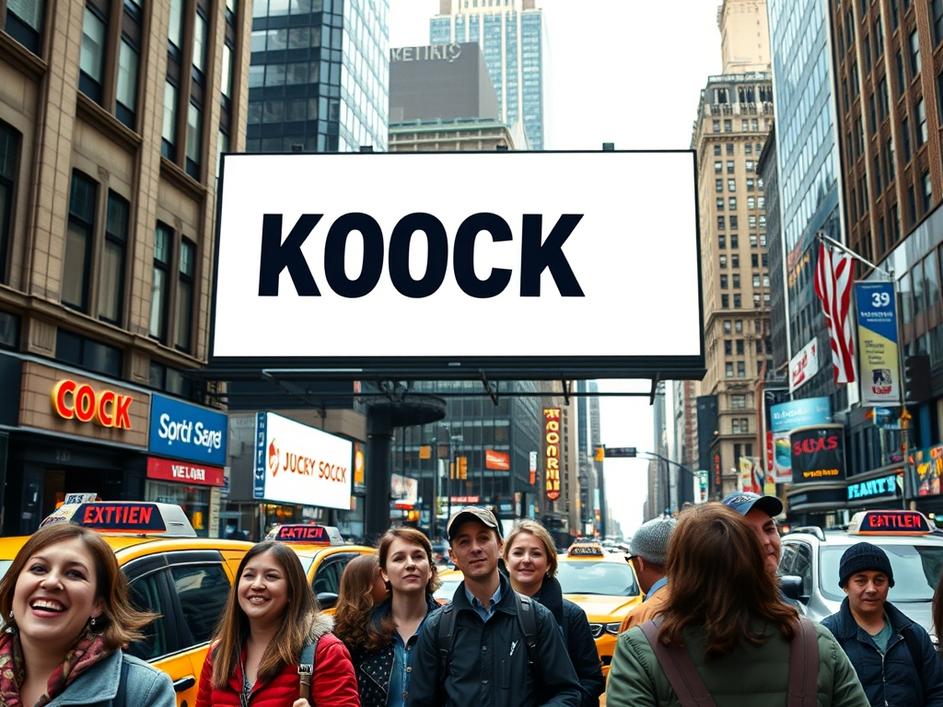


We are a digital agency helping businesses develop immersive, engaging, and user-focused web, app, and software solutions.
2310 Mira Vista Ave
Montrose, CA 91020
2500+ reviews based on client feedback

What's Included?
ToggleNew York City is a canvas for advertising, a place where ads fight for your attention on every corner, every building, and every subway car. We've seen it all: flashy lights, famous faces, witty slogans. But recently, a new billboard popped up that didn't just catch eyes; it made people stop, stare, and then often, snicker. It wasn't a picture of a celebrity or a groundbreaking product. It was just one word, big and bold, splashed across the urban landscape: “KOCK.” And for a city that thinks it's seen everything, this single word sparked a whole lot of questions, a fair bit of confusion, and certainly, a few blushes. You couldn't walk by without doing a double take, a quick glance to make sure you read it right, followed by a knowing look, or perhaps an embarrassed one. It was exactly the kind of unexpected jolt that cuts through the noise of daily life in the Big Apple, turning an ordinary commute into a moment of shared, slightly scandalous, curiosity. This was no accident; this was a very deliberate move by a company called Airlearn.
So, what was the deal with “KOCK”? As it turns out, the meaning behind the buzz isn't what many New Yorkers' English-speaking minds immediately jumped to. This controversial word, prominently displayed for all to see, is actually Swedish. And in Sweden, “KOCK” simply means "chef." Yes, that's right. The language learning app, Airlearn, pulled off a masterstroke (or a questionable move, depending on your perspective) by playing on the phonetic similarity of a perfectly innocent foreign word to a much more provocative English one. This isn't just some random word choice; it's a direct, almost audacious, nod to the very thing Airlearn aims to teach: how language, context, and culture shape our understanding of the world. It was a brilliant, if daring, way to make people suddenly aware of how a word can change its entire meaning just by crossing a border or shifting a language.
In the crowded world of advertising, getting noticed is the ultimate goal. Companies often spend millions trying to find that one ad that sticks, that makes people talk. Airlearn didn't just make people talk; they made them gasp, laugh, and then probably Google. This kind of "shockvertising" is a well-known tactic, but it always walks a fine line. On one side, you have groundbreaking, unforgettable campaigns that become part of pop culture. On the other, you risk alienating your audience, coming across as crude, or simply missing the mark entirely. Airlearn clearly gambled that the initial shock would lead to curiosity, and that curiosity would lead people to their app. They bet that the humor and the eventual reveal of the word's true meaning would outweigh any potential offense. And, judging by the chatter across social media and the actual streets of NYC, it seems like their gamble paid off, at least in terms of pure attention-grabbing power. It certainly got more eyeballs than a generic ad showing happy people learning a language ever would.
For me, this billboard is more than just a clever marketing stunt. It's a fascinating real-world example of how deeply our native language shapes our perception. When we see or hear a word, our brains instantly process it through our own linguistic filters. We attach meaning, emotion, and even assumptions based on what we know. The “KOCK” billboard brilliantly bypassed those filters for a moment, forcing New Yorkers to confront their own immediate interpretations before revealing the broader, international context. It highlights how different cultures can share sounds but attach vastly different meanings to them. This isn't just about learning Swedish; it's about appreciating the rich, sometimes awkward, tapestry of global communication. It's about understanding that what sounds familiar or even offensive in one tongue can be perfectly innocent and everyday in another. Airlearn, by being so bold, isn't just selling an app; it's indirectly selling the concept of cultural humility and the fun of discovering how the world works through different linguistic lenses.
This billboard speaks volumes about the value of language learning in our increasingly connected world. In an age where we interact with people and cultures from all corners of the globe, understanding nuances beyond our own language is more important than ever. This Airlearn campaign, in its playful controversy, serves as a stark reminder that communication isn't just about words; it's about context, tone, and cultural sensitivity. Imagine the misunderstandings that could arise if we don't bother to look beyond our own immediate interpretation of things. By pushing this boundary, Airlearn inadvertently sparked a conversation about the beauty and sometimes humor of linguistic diversity. It encourages us to step outside our comfort zones, question our assumptions, and perhaps, inspire us to learn a new language – not just to speak it, but to truly understand the world through a new pair of linguistic eyes. It's a nudge towards global literacy, delivered with a wink and a smile.
Ultimately, Airlearn's “KOCK” billboard in New York City accomplished exactly what the brand probably hoped for: it got people talking. It ignited conversations, prompted searches, and most importantly, highlighted the core mission of a language-learning app in a way that no polite, traditional ad ever could. It showed us that a single word, in the right (or wrong) context, can be a powerful tool for grabbing attention, sparking debate, and even teaching a subtle, yet profound, lesson about our globalized world. It's a testament to the idea that sometimes, to make a real impact, you have to be a little bit daring, a little bit playful, and not afraid to make people do a double take. So, next time you see a word that makes you scratch your head, remember the chef in NYC. It might just be an invitation to learn something new.



Leave a reply